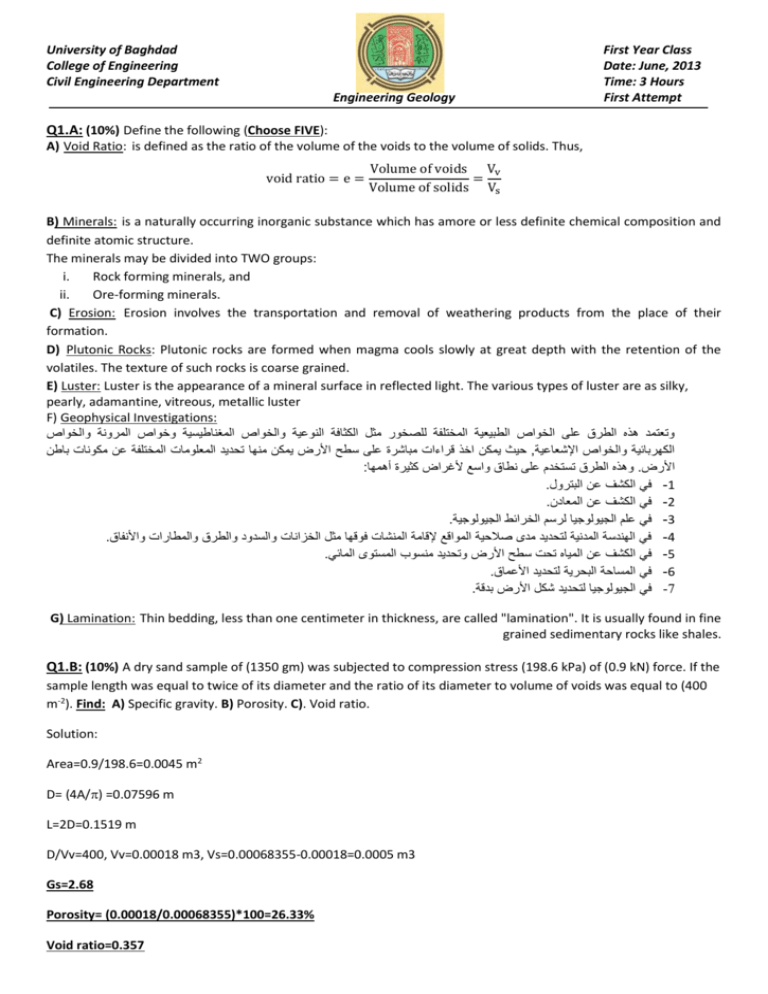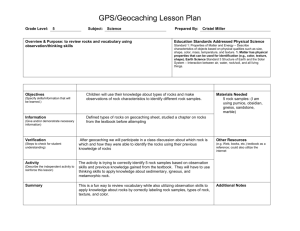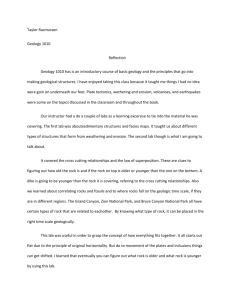University of Baghdad First Year Class College of Engineering Date
advertisement

University of Baghdad College of Engineering Civil Engineering Department Engineering Geology First Year Class Date: June, 2013 Time: 3 Hours First Attempt Q1.A: (10%) Define the following (Choose FIVE): A) Void Ratio: is defined as the ratio of the volume of the voids to the volume of solids. Thus, void ratio = e = Volume of voids Vv = Volume of solids Vs B) Minerals: is a naturally occurring inorganic substance which has amore or less definite chemical composition and definite atomic structure. The minerals may be divided into TWO groups: i. Rock forming minerals, and ii. Ore-forming minerals. C) Erosion: Erosion involves the transportation and removal of weathering products from the place of their formation. D) Plutonic Rocks: Plutonic rocks are formed when magma cools slowly at great depth with the retention of the volatiles. The texture of such rocks is coarse grained. E) Luster: Luster is the appearance of a mineral surface in reflected light. The various types of luster are as silky, pearly, adamantine, vitreous, metallic luster F) Geophysical Investigations: وتعتمد هذه الطرق على الخواص الطبيعية المختلفة للصخور مثل الكثافة النوعية والخواص المغناطيسية وخواص المرونة والخواص حيث يمكن اخذ قراءات مباشرة على سطح األرض يمكن منها تحديد المعلومات المختلفة عن مكونات باطن,الكهربائية والخواص اإلشعاعية : وهذه الطرق تستخدم على نطاق واسع ألغراض كثيرة أهمها.األرض . في الكشف عن البترول-1 . في الكشف عن المعادن-2 . في علم الجيولوجيا لرسم الخرائط الجيولوجية-3 . في الهندسة المدنية لتحديد مدى صالحية المواقع إلقامة المنشات فوقها مثل الخزانات والسدود والطرق والمطارات واألنفاق-4 . في الكشف عن المياه تحت سطح األرض وتحديد منسوب المستوى المائي-5 . في المساحة البحرية لتحديد األعماق-6 . في الجيولوجيا لتحديد شكل األرض بدقة-7 G) Lamination: Thin bedding, less than one centimeter in thickness, are called "lamination". It is usually found in fine grained sedimentary rocks like shales. Q1.B: (10%) A dry sand sample of (1350 gm) was subjected to compression stress (198.6 kPa) of (0.9 kN) force. If the sample length was equal to twice of its diameter and the ratio of its diameter to volume of voids was equal to (400 m-2). Find: A) Specific gravity. B) Porosity. C). Void ratio. Solution: Area=0.9/198.6=0.0045 m2 D= (4A/) =0.07596 m L=2D=0.1519 m D/Vv=400, Vv=0.00018 m3, Vs=0.00068355-0.00018=0.0005 m3 Gs=2.68 Porosity= (0.00018/0.00068355)*100=26.33% Void ratio=0.357 University of Baghdad College of Engineering Civil Engineering Department Engineering Geology First Year Class Date: June, 2013 Time: 3 Hours First Attempt Q2.A: (10%) Give a brief answer in points for the following items: 1- Moh's Scale of the Minerals Hardness: Mohs Scale of Hardness 1 Talc 2 Gypsum 3 Calcite 4 Fluorite 5 Apatite 6 Orthoclase 7 Quartz 8 Topaz 9 Corundum 10 Diamond 2- Types of Folds: Symmetrical Fold, Asymmetrical Fold, Overturned Fold, Recumbent Fold, Isoclinals Fold, Dome and Basin. 3- Usage of Seismic Reflected and Refraction methods. :تقسم طرق التحري الزلزالي إلى نوعين رئيسين هما . الطريقة االنعكاسية حيث تعتمد على الموجات المنعكسة-1 . الطريقة االنكسارية حيث تعتمد على الموجات المنكسرة-2 تستخدم الطريقة األولى في المشاريع التي تحتاج إلى التحري العميق مثل دراسة أسس السدود أو في بناء الجسور و األرصفة عند أما الطريقة الثانية فهي ذات جدوى عالية في المشاريع ذات,الموانئ و ذلك إلعطاء صورة واضحة عن عمق المياه و التضاريس التحت مائية .االهتمام باألعماق المحدودة أي لألعمال الهندسية 4- Ways of transportation of rock debris produced due to glacial erosion: The rock debris produced due to glacial erosion is transported by ice in three ways: 1. Super Glacial Load: The rock debris which is present on the surface of the glacier is called "super glacial load". 2. Englacial Load: The rock debris present within the ice is called "englacial load". 3. Subglacial Load: The rock debris present at the bottom of the glacier is called "subglacial load". 5- Agents of Metamorphism: The agents which bring about metamorphism of rocks are as follows: 1. Physical agents: Heat, uniform pressure, and directed pressure. 2. Chemical agents: Chemically active water and gases. Q2.B: (10%) A specimen of Granite rock with the following properties: Length (20 cm), Radius (5 cm), Dry mass (8690 gm), ratio of Modulus of Elasticity to the Shear Modulus was equal to the ratio of Modulus of Elasticity to Bulk Modulus. Calculate: A) Dry density. B) Poisson's Ratio. C) Longitudinal Strains if the Lateral strains was (0.00075). Solution: Dry density=8690/1570.79=5.532 gm/cm3 E/Shear Modulus=E/Bulk Modulus University of Baghdad College of Engineering Civil Engineering Department First Year Class Date: June, 2013 Time: 3 Hours First Attempt Engineering Geology 2(1+)=3(1-2) =0.125 = Lateral strains/ Longitudinal Strains Longitudinal Strains=0.006 Q3.A: (10%) Sketch with Details the following: 1- Typical Fault. F Foot wall C Hade Throw E D Hanging wall Heave F 2- Types of Marine Sediments. expressed either in cm3 or m3. The phase-relationships in terms of mass-volume 3- Phase relationship for typical soil sample and weight-volume for a rock mass are shown by a block diagram in Fig. 1.1. Wa Air Air Va Vv Ww Water Vw V W Ws Solids Vs Figure 1.1 Block diagram—three phasescarries of a rock Q3.B: (10%) A circular footing with (3.0m diameter) a loadelement of 1000kN. The settlement of footing would be checked at different depth. Find the stress at 0.0, 2.0, 4.0 and 10.0 meters below the footing base. (Use 2:1 method). Depth, m 0 2 4 10 Footing diameter, m 3 5 7 13 Area, m2 7.068 19.63 38.48 132.73 Stress, kPa 141.48 50.94 25.987 7.534 University of Baghdad College of Engineering Civil Engineering Department Engineering Geology Q4.A: (10%) State the difference between each of the following pairs: First Year Class Date: June, 2013 Time: 3 Hours First Attempt 1- Gypsum and Calcite: Gypsum :( CaSO4.2H2O), Scratched by a finger nail. Calcite :( CaCO3), Scratched by a knife. 2- Strike and Dip: Dip: It is the angle of inclination of a rock bed with the horizontal plane. The dip includes both the direction and the angle. The dip direction is measured by its compass bearing and the angle of dip with clinometers. Strike: It is the direction of a line formed by the intersection of the plane of a bed with a horizontal plane. The strike is always at right angles to the true dip. The direction of strike is determined by compass with reference to the true north and south. 3- Tension and Shear Joints: Tension joints are those which are formed as a result of tensional forces. These joints are relatively open, and have rough and irregular surfaces. Shear joints are those which are formed due to shearing stresses involved in the folding and faulting of rocks. These joints are rather clean cut and tightly closed. 4- Acid and Basic Magma: Acid Magma: It is rich in Si, Na, K and poor in Ca, Mg, and Fe. Basic Magma: It is rich in Ca, Mg, and Fe, and poor in Si, Na, and K. 5- Sand Dunes and Loess: Sand Dunes: it consists of fine to medium, rounded and dry sand particles. This soil types always characterized to have nearly same size particles. The size of particles transported by wind depends on the wind speed and its predominated direction. Loess: consists mainly of silt and dust particles, these deposits are typically non-stratified and have a grayish yellow color Q4.B: (10%) A concentrated load of 1000 kN was applied at the surface of sand deposits. The designer requires specific requirements. Among these requirements he wants the stress increments at two points lies 4.0m below the surface. The first point lies at the line of load application and the second one 3.0m away from the line of load application. It is required to give the designer these stresses use Boussinesq's solution. If the same load was applied to a rectangular footing (2.0m ×4.0m), what will be the value of stresses at 4.0m depth? Solutions: For point load=1000 kN Point No. R, m Z, m r/z 𝝈𝒛 𝒊𝒏 𝒌𝑷𝒂 1 0.0 4.0 0.0 29.842 2 3.0 4.0 0.75 9.778 By using the following equation for point load: University of Baghdad College of Engineering Civil Engineering Department Engineering Geology First Year Class Date: June, 2013 Time: 3 Hours First Attempt 𝟑𝑸 𝟏 𝟑 ∗ 𝟏𝟎𝟎𝟎 𝟏 𝝈𝒛 (𝟏) = = = 𝟐𝟗. 𝟖𝟒𝟐 𝒌𝑷𝒂 𝟐𝝅𝒛𝟐 [𝟏 + (𝒓⁄ )𝟐 ]𝟓⁄𝟐 𝟐𝝅(𝟒)𝟐 [𝟏 + (𝟎)𝟐 ]𝟓⁄𝟐 𝒛 𝝈𝒛 (𝟐) = 𝟑𝑸 𝟏 𝟑 ∗ 𝟏𝟎𝟎𝟎 𝟏 = = 𝟗. 𝟕𝟕𝟖 𝒌𝑷𝒂 𝟐𝝅𝒛𝟐 [𝟏 + (𝒓⁄ )𝟐 ]𝟓⁄𝟐 𝟐𝝅(𝟒)𝟐 [𝟏 + (𝟎. 𝟕𝟓)𝟐 ]𝟓⁄𝟐 𝒛 For point load resting on rectangular (2.0×4.0m) 𝝈𝒛 = 𝑸 𝟏𝟎𝟎𝟎 = = 𝟐𝟎. 𝟖𝟑𝟒𝒌𝑷𝒂 (𝑩 + 𝒛)(𝑳 + 𝒛) (𝟐 + 𝟒)(𝟒 + 𝟒) Q5.A: (10%) What are the Mechanical & Chemical Effects of the following Factors? 1- The Rain: the chemical action of rain water is appeared in four processes: oxidation, hydration, carbonation and solution. 2- Organic Matter: (Mechanical) Plants and animals also play important part in the physical weathering of rocks. Plant roots grow into cracks and joints, and push the rock fragments apart. (Chemical)Decay of organic matter may cause a change in the chemical composition of the constituents of the soil. 3- Underground Water: The ground water does erosion mainly by chemical action. The mechanical erosion is negligible as the ground water moves very slowly through the rocks. The erosive action of groundwater is most conspicuous in limestone regions where the water charged with carbon dioxide dissolves calcium carbonate very easily. 4- The Frost :( Mechanical) the freezing of water in the cracks of rocks tend to disintegrate them because water on freezing expands about one eleventh of its volume and therefore, exerts great pressure on the walls of the cracks. By this process angular fragments of rocks are broken from the high mountain ranges. 5- Fluctuation of Temperature during Day & Night: (Mechanical) the heating and cooling of rock masses occur due to daily and seasonal temperature changes. The heat causes them to expand and cooling causes them to contract. The repeated expansion and contraction tend to develop cracks in the rocks. Q5.B: (10%) The following data are obtained for a rock specimen: Mt (total mass) =300gm, Ms (dry mass) =250gm, Gs=2.77 and S=80%. Find the total volume, volume of solids and voids, total and dry unit weight (in kN/m3), void ratio and porosity of the specimen. If the degree of saturation increased to 95%, what will be the value of specific gravity and water content? Solution: Water content=(300-250)/250=0.20=20.0% e=G *w/s=(2.77*.2)/0.8=0.6925 dry density=G/(1+e)=2.77/(1+0.6925)=1.636gm/cm3=16.36kN/m3 Volume of sample=Dry mass/dry density=152.81cm3 n=e/(1+e)=0.409=40.9% University of Baghdad College of Engineering Civil Engineering Department First Year Class Date: June, 2013 Time: 3 Hours First Attempt Engineering Geology n=Vv/V Vv=62.52cm3 Vs=V-Vv=152.81-62.52=90.29cm3 total unit weight=16.36*(1+0.20)=19.632 kN/m3 If the degree of saturation increased to 95% the Gs will not be changed and thwater content will be W=0.95*0.6925/2.77=0.2375=23.75% Q6. A: (10%): Fill in the blanks with a suitable word or number: 1. The major difference between Breccia and Conglomerate ……is having angular fragments instead of rounded pebbles….. 2. If the velocity of the longitudinal reflected wave was (3450 m/s) and the required time to travel from the source to its receiver was (1 s) and the distance between them was (10 m), then the depth of the upper strata is …1724.99m…… 3. If the liquid limit is 110% and the plastic limit is 55%, the plasticity Index is …55… %. 4. A soil with specific gravity of (2.67) and a void ratio of (0.67) should have a dry density of ……15.99…. kN/m3. 5. Streak is … is the color of mineral powder … Q6. B: (10%) The depth of water in a well shown in the Figure No.1; is (3 m). Below the bottom of the well lies a layer of SAND 5 meters thick is overlying a CLAY deposit. The specific gravity of the solids of SAND and CLAY are respectively 2.64 and 2.70. Their water contents are respectively 25 and 20 percent. Compute the TOTAL, PORE WATER and THE EFFECTIVE STRESS at POINTS A and B. Figure No. 1 Solution: S=100%, e=Gs*w Point location A B e 0.66 0.54 Saturated Total stress, kPa density 1.987 =3*10+3*19.87=89.61 2.103 =3*10+5*19.87+2*21.03=171.41 Pore pressure, kPa =6*10=60 =10*10=100 Instructors: Abbas F.Ibrahim and Mohammed A.Jabbar Effective Stress, kPa 29.61 71.41







